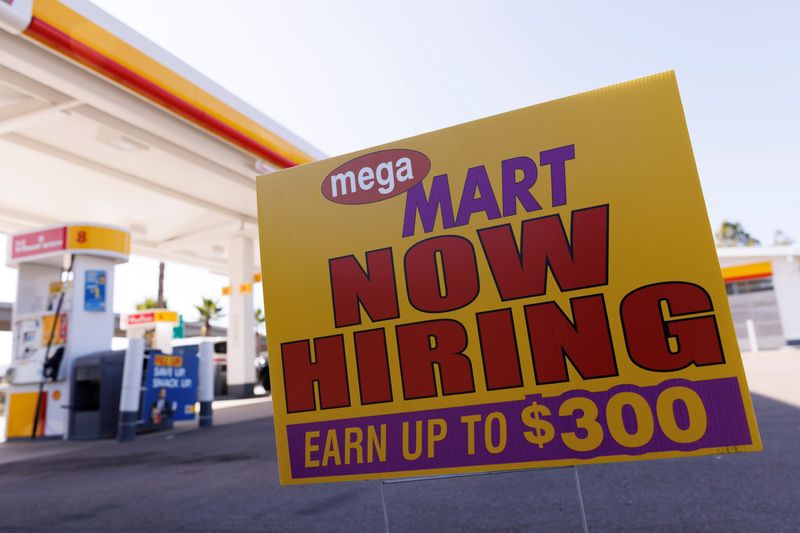
© Reuters. A job posting looking for workers is shown at a gas station in San Diego, California, U.S. November, 9, 2021. REUTERS/Mike Blake
By Lucia Mutikani
WASHINGTON (Reuters) – U.S. job growth slowed more than expected in June after surging in the prior month, but labor market conditions remain tight, with the unemployment rate retreating from a seven-month high and fairly strong wage gains continuing.
Nonfarm payrolls increased by 209,000 jobs last month, the Labor Department said in its closely watched employment report on Friday. Data for May was revised lower to show payrolls rising 306,000 instead of 339,000 as previously reported.
Economists polled by Reuters had forecast payrolls rising 225,000. The economy needs to create 70,000-100,000 jobs per month to keep up with growth in the working-age population. The unemployment rate slipped to 3.6% from 3.7% in May.
Though job growth is slowing, the labor market remains unbowed despite the Federal Reserve delivering 500 basis points worth of rate hikes since March 2022 when it embarked on its fastest monetary policy tightening campaign in more than 40 years. For now, it is helping the economy to defy economists’ predictions of a recession.
Average hourly earnings rose 0.4% last month after climbing by the same margin in May. In the 12 months through June, wages increased 4.4%, matching May’s advance.
Annual wage growth remains too high to be consistent with the Fed’s 2% inflation target. The U.S. central bank is almost certain to resume raising interest rates later this month as signaled by Fed Chair Jerome Powell, after pausing in June.
While the higher paying industries like technology and finance are purging workers, sectors like leisure and hospitality as well local government education are still catching up after losing employees and experiencing accelerated retirements during the COVID-19 pandemic.
Companies are also hoarding workers, a legacy of the dire labor shortages experienced as the economy rebounded from the COVID-19 downturn in 2021 and early 2022.
But some economists argued that worker hoarding was masking weakness in the economy, pointing to worker productivity, which slumped in the first quarter. They also noted that while gross domestic product, the traditional measure of economic growth, was solid in the January-March quarter, an alternative gauge, gross domestic income, has contracted for two straight quarters.
Though businesses are content for now to continue hoarding workers, that could change once slowing consumer spending starts to erode profits, the economists said, predicting major layoffs.
There are also concerns that the slowdown in wage growth, driven by the loss of high-paying technology and finance jobs among others, portends slower consumer spending, the main anchor of the economy.





